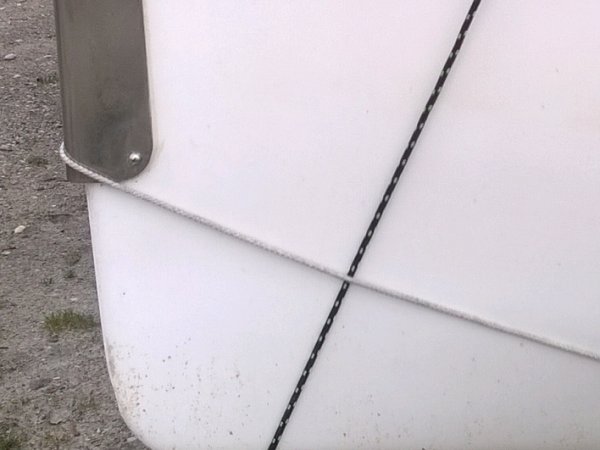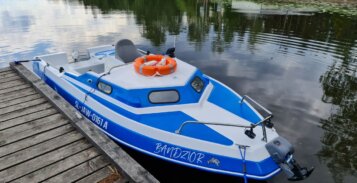
„The holiday period ended and my yacht was left for 2 months in one of the north ports of Giżycko. Sailors know that it is related to the permanent exposure to strong Autumn winds which may contain many pollutions and enhanced probability of the settlement of algae and lichens on the bottom of the yacht. That’s what indeed happened to my Twister. When in November I pulled it out from the port basin, sadly I noticed what I had expected – the bottom was almost completely black due to the lichens.
Just before the arrival, on the Internet I was watching products of various companies and I came across C1 Sea-Line – the anti-fouling product. As a rule, I do not trust new products without getting an opinion about them, but a simple description of use and a comfortable sprayer tempted me to buy this product. While washing the yacht there was a drizzle which made it more difficult to maintain the applied anti-fouling product on the hulk so I continuously had to cover the elements, which I was washing, with a tilt.
At the same time I was hurrying because it seemed that there was going to be a downpour in the evening. In spite of inconvenience and the lack of appropriate equipment (I was spreading the anti-fouling product with a simple brush and the rain was rinsing it), the effect was surprising. Just like it says in the manual, after the second wash, the yacht looked the way it looked like during the regattas – white and fragrant. Anti-fouling C1 is an excellent product for a very affordable price. I have experienced myself that it is worth buying Sea-Line products, therefore during the next season I am going to secure the whole bottom with Sea-Line® S4 Protect Wax.”
We kindly thank Jacek from Warsaw for the materials.

Désolé, cet article est seulement disponible en Polonais et Anglais Américain.

Opinion of our distributor from Bulgaria, Nicolai from Watersports Equipment – Varna, who works with Sea-Line for 5 years. « Watersports […]

Opinion of our distributor from Switzerland, Jürg from ANWANDER – Näfels. ‘My name is Jürg Iselin from ANWANDER in Switzerland. […]

Opinion of our distributor from Gibraltar, Gaynor from GIBYACHTS – Gibraltar. « Wanted to take few moments to talk to you […]
There is a possibility of thinning antifouling, but we do not recommend this procedure due to the risk of reducing the effectiveness of the paint. If it is necessary to thin the antifouling paint, it is recommended to dilute it to a maximum of 0-5% (by volume).
Yes, you can mix Sea-Line polyurethane paints. The only difference are the pigments of polyurethane paints that determine the color of the paint. But remember to keep the right proportions of base, hardener and thinner.

Le produit destiné au remplissage des lacunes et à la liquidation des inégalités résultant des dommages ou des inégalités qui […]

La protection de la surface du bateau contre l’influence destructrice de l’osmose et de la corrosion dans des conditions difficiles

La protection contre l’eau et contre l’influence néfaste des rayons UV

La protection du fond du bateau contre l’encrassement par les algues et contre les coquillages. La protection contre l’eau

Une élimination efficace des fissures, le rafraîchissement de la couleur et du brillant du gel coat ou du vernis

Préparations spéciales pour le nettoyage et la remise en vigueur

Laminage, collage et de remplissage des fissures dans gelcoat

Beaucoup de produits utiles pour les travaux de construction d’un bateau